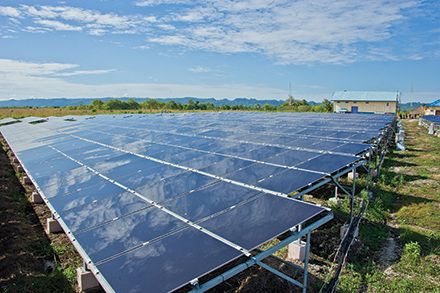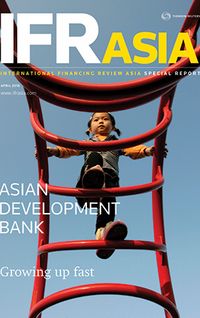Asia has been a laggard in the global growth of sustainable investments, but interest in Green financing is growing fast. The ADB is backing steps to boost both supply and demand.
Growing global demand for responsible investments has created an opportunity for Asia to finance more sustainable, long-term projects through the institutional capital markets. Connecting issuers and investors, however is proving a frustrating task.
Asian issuers see little benefit from “Green” financings that are just as expensive as conventional debt – or even more costly, given the additional opinions and monitoring required. And demand for responsible assets is yet to take off in the region’s emerging markets, where price and absolute return are the dominant drivers for investors.
The ADB, which has been at the forefront of developing Asia’s local capital markets since the Asian financial crisis two decades ago, is taking up the challenge.
“Green bonds are a natural fit for infrastructure financing,” said Avonechith “Noy” Siackhachanh, senior adviser to the Economic Research and Regional Cooperation Department.
“In the context of more advanced markets like the US or Europe, you want to switch to new technology to promote cleaner development, but in our case we are starting from a low base, in terms of infrastructure. That’s why we are promoting Green bonds for infrastructure under the Asian Bond Market Initiative.”
The ABMI, and the related Asian Bond Market Forum, is an initiative of the ASEAN+3 grouping covering the South-East Asian region, China, Japan and South Korea. The ADB, which acts as the secretariat, has welcomed the introduction of Green bond standards for the ASEAN region, signed in November last year.
Noy at the ADB describes the growth of Green bonds as “very exciting”, both for the development of Asia’s financial markets and for the region’s push to reduce emissions.
“We are looking at all aspects of the Green market in the region. We want to highlight to policymakers in our region (ASEAN+3) that you can’t just promote Green bonds on their own. You have to link it to national strategy in addressing climate change,” she said. “It has to be part of the climate initiative or else it doesn’t work.”
The ADB and the ABMI are backing efforts to stimulate both supply and demand.
On the buyside, Noy recognises that more education around environmental, social and governance (ESG) strategies can help create a broader base of investors for green assets.
“We are recommending to ASEAN+3 that they must look at ESG. They should encourage responsible institutional investors to be more aware of ESG, including the benefits of what it does, and make ESG part of the requirement of licensing to become an institutional investor,” she said.
Few Asian institutional investors have signed up to global responsible investment standards, such as the United Nations’ PRI programme, and absolute returns remain the primary focus for most of the region’s fund managers.
That, Noy says, is not the main hurdle.
“The demand side in our region is not too much of an issue, as there is so much demand for investments,” she said. “On the issuer side, they are not so comfortable with the costs and monitoring involved.”
Green bonds rarely deliver lower borrowing costs for issuers, since they are also offered to conventional investors and are based on market pricing (although there have been some exceptions in Australia, where dedicated state funds add to demand).
Instead, borrowers looking to meet global standards need to pay for an independent second opinion, which can run to around US$50,000 – small fry for a major issuer, but a significant barrier to Asia’s smaller companies.
Singapore and Hong Kong have offered to help offset these costs through grants, in the hope of attracting more issuance and showcasing their own green credentials. Hong Kong this year announced a three-year grant scheme to cover half of the issuance costs for eligible first-time Green bond issuers in Hong Kong, capped at HK$2.5m (US$318,473). The Monetary Authority of Singapore has offered to cover 100% of the costs of an external review, up to S$100,000 (US$76,291) per issue.
Noy at the ADB is in favour of expanding those schemes across the region.
“We are suggesting (to ASEAN+3) that we could set up a facility similar to the one that MAS is doing in Singapore to try to help offset some of the costs for a potential issuer,” she said.
But she stops short of promoting tax incentives for investors or less-targeted subsidies, saying these are “not good economics”.
Green financing should fit in an issuer’s financing strategy, rather than allow it to pile on more debt at a lower cost.
“Why do people want to issue Green bonds? One, they want to broaden their investor base. Two, they want to build their reputation as a responsible issuer,” said Noy.
There have been some notable successes. Star Energy, an Indonesia power producer with a big geothermal portfolio, sold a US$580m 15-year bond, callable after eight years, on April 17. The secured deal refinanced project loans in the institutional market and was the first Green bond from Indonesia’s corporate sector.
GLOBAL STANDARDS
Asian issuers are also finding themselves at the centre of the global debate around green standards. Some investors argue that green financings do not come with enough safeguards to prevent the proceeds from being misused, since many deals are self-labelled, and compliance is voluntary. And individual countries have imposed their own rules, which often differ from the global standard.
China has a set of mandatory guidelines for state-owned enterprises that require only 50% of the proceeds of a “Green” financing to go towards green assets – putting some of the debt off limits for dedicated green funds.
The ASEAN Green bond guidelines, released in November, are in line with the global Green Bond Principles, a set of rules managed by the International Capital Market Association in its secretariat role.
Even under those rules, however, there are concerns over “greenwashing”, where an asset may not be as green as claimed.
A €500m Green bond in 2017 from Spain’s Repsol proved controversial, as some green funds refused to invest in debt from an oil and gas company – even though it adhered to the Green Bond Principles and promised to reduce the company’s carbon dioxide emissions.
Bangchak Petroleum, a Thai oil company, sold a Bt3bn Green bond in February 2015, split between 12-year and 15-year tranches, to finance a push into renewable energy. Local life insurers bought the self-labelled deal, but the global Climate Bonds Initiative said it did not have enough information to be confident calling it a Green bond.
At the other end of the spectrum, the ADB itself is committed to being a regular Green issuer. It last issued Green bonds in August 2017, raising US$1.25bn in a five-year and 10-year offering. The second opinion on the bank’s Green bond framework comes from UN-backed Cicero, the Center for International Climate and Environmental Research – Oslo.
The ADB is on track to double its annual climate-aligned financing commitments to US$6bn from 2015 to 2020, accounting for around 30% of its overall financing by the end of this decade.
To see the digital version of this roundtable, please click here
To purchase printed copies or a PDF of this report, please email gloria.balbastro@tr.com



